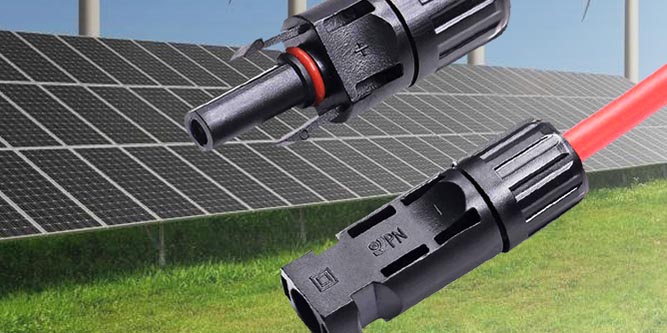These days, millions of people are installing solar panels on their property. This can be for any number of reasons. For one thing, there’s the obvious benefit to the environment, and the warm, fuzzy feeling of lowering your carbon footprint. For another thing, you can save money on your monthly power bill, and potentially pay nothing. In the past, solar panels could take 25 years or more to pay themselves off. But some modern solar panels earn back their cost in as little as 10 years. And if you take advantage of federal tax credits, they can pay for themselves even faster. With all of these things going in their favor, it’s no surprise that solar panels are more popular than ever.
But solar power isn’t just for your home. Solar is becoming increasingly popular for RVs, simply because it’s cheaper than a gas generator. RVs are already notorious gas hogs. So if you can at least generate clean power, you’re minimizing your carbon footprint. Along the same lines, solar backup generators are useful for campers, and even for emergency preppers. In a major emergency, you might not be able to fill a gas generator. But you can always put a solar panel out and charge that way.
In all of these scenarios, you’re going to need the right kind of cable. When you’re installing solar panels, the panels need to be wired together. And if you’re charging a battery, you need to connect the panel to the charger. Thankfully, there’s a standard for these cables, called MC4, which is more or less universal. That said, you still need the right gauge and length. You also need a cable with the best possible UV and weather-resistance.
Today, we’re going to review three of the best MC4 solar extension cables available online. We’ll begin by looking at the WindyNation Solar Extension Cable. This is a pair of 10- or 12-gauge cables available in multiple lengths. Next, we’ll check out the Renogy Solar Extension Cable. This is a single 10- or 12-gauge cable with exceptional UV resistance. Finally, we’ll examine the Temank Solar Extension Cable. This is a pair of durable, flame-retardant cables for almost any application. But which one is going to be the right one for your needs? To find out, we’ll have to take a much closer look at all three of them. Once we’ve gotten a good look at all of their features and benefits, we’ll be able to deliver a fair judgement. Let’s begin!
Solar Extension Cable Features
So, what makes one solar extension cable better than another? To begin with, let’s talk about gauge. Gauge is a measure of a wire’s diameter and capacity, and it’s measured in American Wire Gauge (AWG). AWG is actually based on resistance, so the numbers are the opposite of what you’d expect. A lower number indicates less resistance, or a bigger wire. The higher the number, the more resistance, and the smaller the wire.
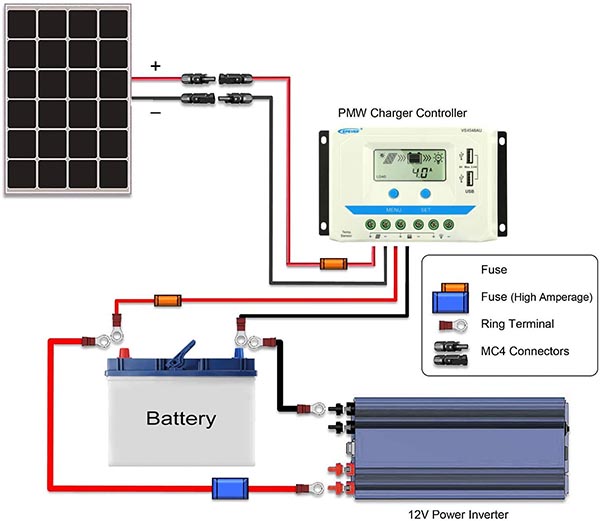
To understand why this is important, think of a garden hose. If the hose has a larger diameter, more water can flow through it. The narrower the hose, the harder the water will have to push to get through. In other words, the hose will be providing more resistance. Along the same lines, a longer hose will provide more than a shorter one of the same diameter. The same is true for electrical wiring. The thicker the wire and the shorter the run, the higher the capacity. The narrower the wire and the longer the run, the less power you’ll be able to put out.
Individual solar panels can use either a 12-gauge or 11-gauge wire. Smaller panels under 50 watts typically use a 12-gauge, which allows up to 20 amps of current. Larger panels use thicker, 10-gauge wires that can support up to 30 amps of current. If you’re wiring multiple panels in parallel, you’ll typically be using a combiner wire. This is a heavier, 3- to 8-gauge wire harness that can support the entire combined current. All the wires we’re reviewing today are either a 10- or a 12-gauge.
Larger gauges are used for battery banks. The most common size is 1/0, pronounced as “one-aught.” However, even larger 3/0 wires can be used for larger 48-volt systems. Note that inside a battery bank, it’s important to use the same gauge and wire length throughout. Even minor differences in length can reduce your system’s efficiency and damage your batteries. Differences in gauge can cause issues to occur even faster. If you can get a set of identical patch cables, you’ll be well set up.
For ordinary 10- and 12-gauge cables, you shouldn’t have many issues with length. As long as your cable is the right gauge for your panel size, you should be fine. That said, for very long runs, you might need a more powerful gauge. Your solar panel should come with a guide or chart telling you what gauge is required for various distances. When in doubt, don’t rely on internet guides. Follow your manufacturer’s written instructions, and use the appropriate cable. Failure to do so could void your panel’s warranty.
Another thing to look for in a good cable is UV resistance. By definition, you’re using your solar panels in the sun. Unless you’re using a covered raceway, your cables will be exposed to that same sunshine. Cheap insulation material can break down quickly in the sun, and crack and dry out. Eventually, this will compromise the cable’s integrity, and you end up with a short circuit. At that point, you have to perform a painstaking diagnosis of your solar system in order to solve the problem. Much better to use a high-quality, UV-resistant cable to begin with.
Along the same lines, a good solar cable should be water-resistant. The cable itself isn’t an issue here, since it’s going to be enclosed in insulation. But look for good quality tips that don’t leak. Just like your cables will be exposed to the sun, they’re going to be exposed to rain. The last thing you want is for water to get into your connectors and cause a short in your system.
MC4 Connector Basics
Whether you’re connecting a single solar panel or an entire array, you’ll need the right kind of plug. Nowadays, there’s only one accepted standard: the MC4. That said, you might also encounter an MC3 connector if you’re working on an older system. But what sets these two apart? Let’s start with the MC4. Not only is it the current standard, but it’s the type of connector used by all of today’s extension cables.
The MC4 standard was originally introduced in 2011, with a couple of important upgrades to the MC3. To begin with, the contact pin on the MC4 is larger. The “4” here is the size of the 4mm contact pin. This is noticeably larger than the MC3’s 3mm contact pin. In other words, while they might be cosmetically similar, the two standards are not compatible. Barring any other issues, the pins won’t make proper contact.
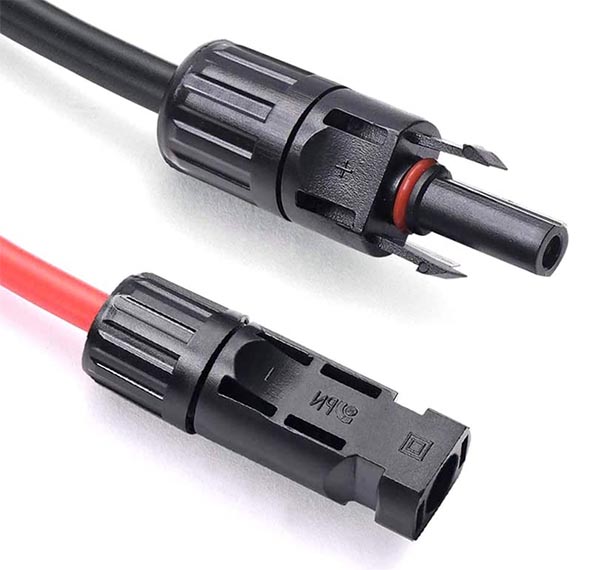
The MC4’s larger contact pin allows for an increase in maximum voltage. At 20 amps, an MC3 connector can support a maximum of 600 volts. If you’re trying to install a very large solar array, you can end up running into a ceiling. At first, MC4 connectors were all limited to this 600-volt ceiling. But European developers have been using 1,000-volt systems for several years now. And in the US, you can find some newer connectors that support 1,500 volts at the same amperage. Keep in mind that if you change the amperage, the voltage limit changes. For example, a 600-volt MC4 connector would only support 300 volts if you double the amperage to 40.
With all of that being said, the most important upgrade to the MC4 connector is safety. The MC3 connector can come apart on its own if the wires are under stress. There’s no locking mechanism to keep the plug together. If the contact pins get separated by a few millimeters, arcing can occur. This will melt the connectors, and could even start a fire. The MC4 standard, on the other hand, has a set of locking pins that engage when the plugs are connected. They can only be opened with a specialized tool, so the risk of arcing is significantly reduced. Because of this, the National Electrical Code now only allows for MC4 connectors.
Other than that, both MC4 and MC3 are similar. Both are gendered, with separate male and female plugs. They’re both easy to connect by hand, without the need for special tools. That said, if you run into an MC3 connector, consider upgrading it to MC4. It takes just a few minutes to splice on a new connector, and your solar system will be much safer.
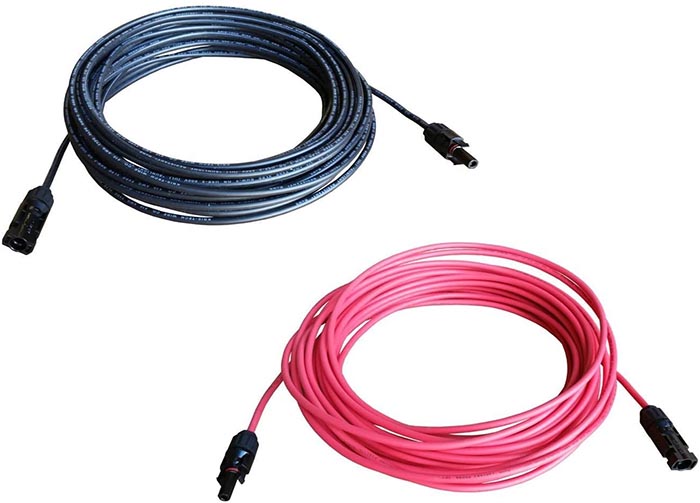
WindyNation Solar Extension Cable
The WindyNation Solar Extension Cable is actually a set of two cables, in red and black. This makes it easy to keep track of the positive and negative side in a complete circuit. The kit comes in an impressive 14 different lengths, so you can get the exact length you need for your job. The lengths are 3, 5, 10, 15, 20, 30, 40, 50, 60, 70, 80, 90, 100, and 150 feet. So if you have a very long run, you’ll be able to make it work. And if you only need a short cable, you won’t have to do any splicing, or leave any slack loose.
In addition to offering a ton of different lengths, WindyNation also provides your choice of gauge. Any size can be ordered in either 10- or 12-gauge, so you can save money wiring lower-voltage systems. The only exception is the 10-foot cable, which is inexplicably only available in the 10-gauge size. The MC4 connections are very good quality, with corrosion-resistant contacts, and the cable is both UV- and moisture-resistant.
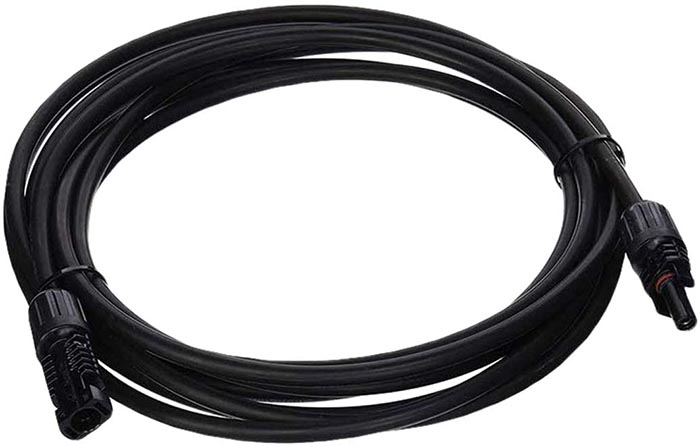
Renogy Solar Extension Cable
Renogy is well-known for their high-quality solar cables and accessories, such as their 12V LiFePO4 battery. The Renogy Solar Extension Cable is of similarly high quality. The black cable material is thick and durable, and is highly resistant to sunlight. The MC4 tips are also solidly constructed, with weatherproof connections.
This cable comes as a single piece, not as a pair. So if you only need one cable for your job, you can save some money here. It can be ordered in 10-gauge in lengths of 5, 10, 15, and 40 feet. If you prefer a lighter 12-gauge cable, you can choose between 10 feet and a tiny 1.5-foot patch cable.
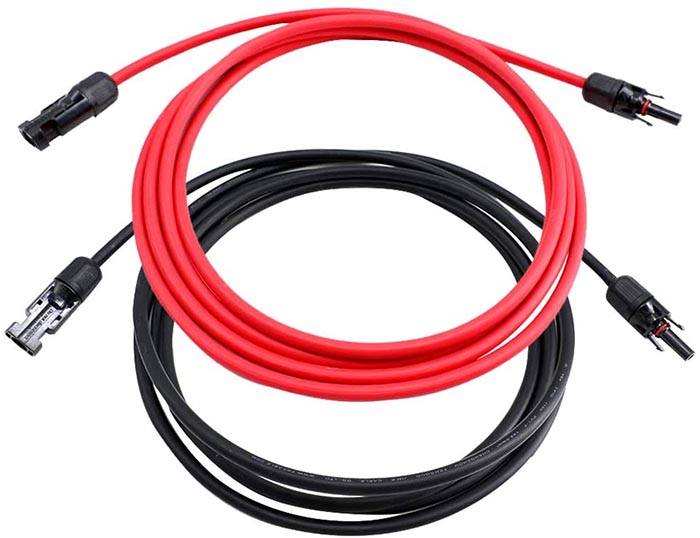
Temank Solar Extension Cable
Like the WindyNation cable, the Temank Solar Extension Cable comes as a pair, in black and red. You can choose between five different lengths, at 10, 20, 30, 40, or 50 feet. All lengths are available in 10-gauge cable only. If you want a lighter-gauge cable, you’ll need to go with a different option.
That said, this is one of the more rugged cables we’ve seen. To begin with, the PPO insulation is exceptionally durable. It’s not just resistant to ultraviolet radiation, but it also remains supple even in extreme temperature conditions. If that’s not enough, the material is flame-retardant, and will extinguish itself if it catches fire. The tips are of equally high quality, constructed from corrosion-resistant material for longevity.
Final Verdict
So, which one of these solar extension cables is the right choice for you? The WindyNation Solar Extension Cable comes with the most options. If you need to make a very long run, you can do it without daisy-chaining and adding extra resistance.
The Renogy Solar Extension Cable provides the best value. It’s great for repair jobs, since you’re only buying a single cable, not a pair. And if you just need the little patch cable, you can order it for a song.
The Temank Solar Extension Cable is the most durable of the bunch. If you’re in a very cold area, or one that’s particularly hot and dry, the insulation will last for longer. You also don’t have to worry about moisture quite as much as you will with most cables.
Meet Ry, “TechGuru,” a 36-year-old technology enthusiast with a deep passion for tech innovations. With extensive experience, he specializes in gaming hardware and software, and has expertise in gadgets, custom PCs, and audio.
Besides writing about tech and reviewing new products, he enjoys traveling, hiking, and photography. Committed to keeping up with the latest industry trends, he aims to guide readers in making informed tech decisions.

